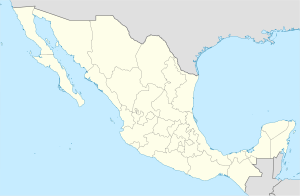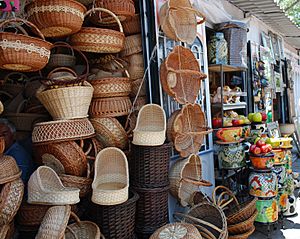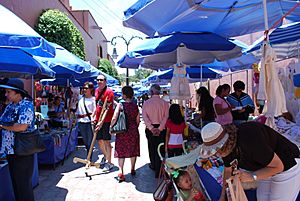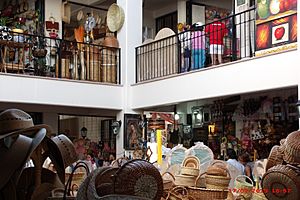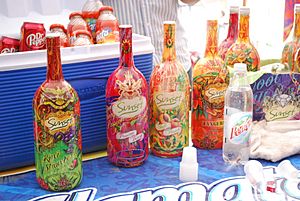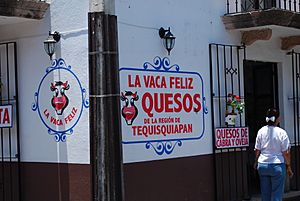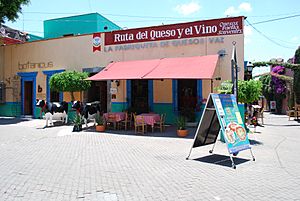Tequisquiapan facts for kids
Quick facts for kids
Tequisquiapan
|
||
|---|---|---|
|
Town & Municipality
|
||
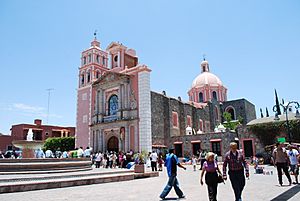
Iglesia Santa María de la Asunción at the Main Plaza of Tequisquiapan
|
||
|
||
| Nickname(s):
the drowned town
|
||
| Country | ||
| State | Querétaro | |
| Founded | 1551 | |
| Municipal Status | 1939 | |
| Area | ||
| • Municipality | 343.6 km2 (132.7 sq mi) | |
| Elevation
(of seat)
|
1,880 m (6,170 ft) | |
| Population
(2005) Municipality
|
||
| • Municipality | 54,929 | |
| • Seat | 26,858 | |
| Time zone | UTC-6 (Central (US Central)) | |
| • Summer (DST) | UTC-5 (Central) | |
| Postal code (of seat) |
76750
|
|
| Area code(s) | 414 | |
Tequisquiapan (pronounced tek-ees-kee-AH-pan) is a charming town and municipality in the state of Querétaro, central Mexico. Its name comes from the Nahuatl language and means "place of tequesquite," which is a natural salt.
The town center has old-fashioned cobblestone streets. You'll see traditional houses with wrought iron details, balconies, and wooden windows. This style comes from its 300-year history as a colonial town. Many people from nearby cities like Querétaro and Mexico City visit Tequisquiapan on weekends. They enjoy the warm climate and natural water springs.
Tequisquiapan is also famous for its wines. It's part of Querétaro's Wine Route. The town even hosts a yearly event called the Feria Nacional del Queso y el Vino (National Cheese and Wine Fair). This fair shows off the delicious cheeses and wines made in the region.
Contents
Exploring the Town of Tequisquiapan
Tequisquiapan is a popular spot for tourists, especially on weekends. Visitors come to see the old church, walk the pretty streets, and enjoy fun places. There's an 18-hole golf course and several water parks called "balneários." Some popular ones are El Oasis and Thermas del Rey.
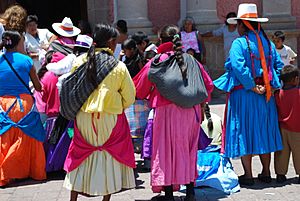
The Main Square and Church
The heart of Tequisquiapan is the main square, named after Miguel Hidalgo y Costilla. It's a big, open area with the Santa María de la Asunción Church facing it. On one side of the square, you'll find a stone kiosk. Bands often play live music here, like jazz and rock.
Along another side of the plaza, there are stone arches. Behind these arches, you can find shops selling sweets, silver, furniture, and crafts. There are also nice cafés and restaurants. The Santa María Church was first built in the 1500s, but the building you see today is from the 1800s. It has a simple, elegant style and is made of pink stone. The clock in its tower is from 1897.
Traditional Buildings and Streets
Around the main square, many buildings still look very traditional. The streets are made of cobblestones, and the houses are simple and rustic. This is because for a long time, the town was mainly home to indigenous people. Many buildings are two stories tall and painted in bright colors like yellow and green. They have balconies and pretty iron details on their doors and windows. You'll often see flowerpots too!
The streets can get crowded with cars, especially on weekends. While some old trees have been lost, many original juniper trees along the river are still there. Newer parts of town have homes built for weekend visitors. These new homes often copy the style of the older buildings.
Legends and Trolley Tours
Tequisquiapan has many interesting local legends. To help visitors explore, there's a special trolley-replica bus. It takes you to different landmarks, including places where these legends are set. On weekends, actors in old costumes sometimes act out these stories.
Shopping for Crafts
Shopping is another fun activity in Tequisquiapan. You can find many handcrafts and folk art. The most traditional crafts here are baskets and furniture made from wood, wicker, and other natural materials. However, you can also buy crafts from all over Mexico.
The main markets are on Ezequiel Montes Street. You'll find the municipal market and other craft markets there. Many street vendors also sell items from stalls or by walking around. You can often buy sweet breads, dried fruit, and other sweets. A special local sweet is crystallized nopal cactus. Otomi women from a nearby municipality often sell their crafts in the main plaza. These include embroidered cloths, rag dolls, pottery, and baskets.
Parks and Green Spaces
La Pila is the most important park in the municipality. It's just north of the main town square. This park has fresh water springs, lots of trees, and grassy areas perfect for picnics. An old water mill used to be here, and a reservoir built in 1567 can still be seen. Today, La Pila is a beautiful area with Montezuma cypress and ash trees. It's also where the annual Feria Nacional del Queso y el Vino takes place. Other parks include El Portón and El Salitrillo.
Cultural Spots and History Markers
The Callejón del Piojo (Louse Alley) is a historic street that was recently updated. It now features fine arts and crafts and hosts cultural events. The Cultural Center (Centro Cultural) has art shows, concerts, and workshops. It also has a large library.
In the early 1900s, Mexican president Venustiano Carranza visited Tequisquiapan. He declared it the "geographical center of the country." While this honor is now usually given to Zacatecas, there's a monument in Tequisquiapan to remember his decree.
The two oldest neighborhoods are Barrio de la Magdalena and San Juan. Many old chapels built for the indigenous people are here. In Barrio de la Magdalena, there's a large mesquite tree in a chapel's courtyard. People say the town's founding mass happened here. This event is re-enacted every June.
Bullring and Old Train Station
The town has a bullring that hosts bullfights, flamenco dance shows, and concerts. There's even a Bullfight Fair in March. The old Bernal railroad station is also worth a visit. It was built when the train line came through. Today, it offers great views of the town and has an old locomotive from the early 1900s.
Local Festivals and Traditions
Tequisquiapan has many special festivals and traditions.
- Holy Cross Festival: On May 3, the San Juan neighborhood celebrates the Holy Cross. A highlight is the dance of Moors and Christians.
- Our Lady of the Assumption: August 15 is the feast day for the town's patroness, Our Lady of the Assumption. People from all over the municipality come to the church for traditional dances and ceremonies like confirmations. The day ends with a fireworks display.
- Holy Week: During Holy Week, the town performs a Passion Play. It starts at the main square and moves through the streets to Monte Calvario, where the crucifixion of Christ is re-enacted.
- Town Founding Celebration: On June 24, the town's founding is celebrated in Barrio de la Magdalena. Actors in 16th-century clothes re-enact the founding mass.
- Pilgrimage to Cerro Grande: On September 13, people make a pilgrimage to a chapel on Cerro Grande hill. They spend the night there, and after a morning mass, they picnic.
- Saint Isidore the Laborer: May 15 celebrates Isidore the Laborer, asking for good crops. A procession goes from the Santa María de la Asunción church to the El Llano chapel.
- Christmas Eve Parade: A special Christmas tradition is a parade on Christmas Eve with floats showing Biblical scenes.
One unique local tradition is making "cruces de animas" (crosses of encouragement). These crosses represent loved ones who have passed away. They can be simple or very detailed and are often seen on family altars or in chapels in the old neighborhoods.
Feria Nacional del Queso y el Vino
The Feria Nacional del Queso y el Vino (National Cheese and Wine Fair) started in the 1980s. Its goal is to promote the region's delicious wine and cheese. The fair highlights the large amounts of wine and cheese produced in Querétaro each year.
Most of the fair takes place at La Pila Park in the town center. But there are also cultural events, talks, contests, charreadas (Mexican rodeos), and concerts. The main tent features wine and cheese makers from Mexico and other countries. A festival queen is crowned by the municipal president.
The fair is supported by the local government and tourism agencies. Many famous artists and bands have performed at the event. The fair is very successful, bringing many visitors and boosting the local economy.
The Municipality of Tequisquiapan
The town of Tequisquiapan is the main center for about 200 other smaller communities. The entire municipality covers an area of 343.6 square kilometers. Most of the people (over 77%) live in just five main communities, with about half the population in Tequisquiapan town itself. Other important communities include San Nicolás and La Fuente.
The municipality is in the southeast of Querétaro state. It's close to the industrial city of San Juan del Río and about an hour's drive from the city of Querétaro. This makes it a popular weekend destination, and many second homes have been built here. The local government is led by a municipal president and thirteen officials who represent the different communities.
Education and Services
The municipality has schools for all ages, from preschools to high schools. There are also special education schools. Most homes in the municipality are owned by the people who live in them. Basic services like running water and garbage collection are available to most residents. Newer buildings often use concrete and cinderblock, but they often copy the traditional "rustic" style of older homes.
Transportation
Federal Highway 120 is the main road for the municipality. It connects Tequisquiapan to San Juan del Río and further north into the mountains. Other important roads link it to nearby towns and the state of Hidalgo. Most roads in the municipality are paved.
Archaeology and Ecotourism
La Trinidad has an interesting archaeological site that dates back to 750-900 CE. There are plans to turn it into an ecotourism site called Dö Mëkuni. This project would protect local plants and animals and offer activities like rappelling, zip-lines, and rock climbing. It would also include a museum about the archaeological site.
The municipality also hosts the annual Rally de Tequisquiapan, an auto race that starts in town and goes through the mountain roads of Querétaro.
History of Tequisquiapan
Early Times
People have lived in the area of Querétaro for thousands of years. The oldest human remains found in a cave in San Nicolás show that early people lived here. Later, people started farming and making pottery.
By the time the Spanish arrived, the area was mainly home to the Otomi people and the Chichimeca people. The Otomi were more numerous and lived peacefully with the Chichimeca. The area was known for its fresh and thermal springs, which people used for health.
Spanish Arrival and Founding
The Spanish took over the Tequisquiapan area fairly peacefully, though the Chichimecas did resist at times. The town was officially founded in 1551 by an indigenous leader named Nicolás de San Luis Montañez, who was allied with the Spanish. The new settlement was named Santa María de la Asuncón y de las Aguas Calientes. The founding was celebrated with a Mass.
The Spanish brought new farming methods, which led to a lot of agricultural growth. However, this often came at the expense of the indigenous people. By 1656, the town was officially named Tequisquiapan. Even with changes, the town kept much of its traditional architecture because many indigenous people continued to live there.
Modern Times
In the 1800s, Tequisquiapan became an official town in 1861. During the Mexican Revolution (early 1900s), armies passed through the area, but no major battles were fought here. The Centenario Dam was opened in 1910.
After the Revolution, Tequisquiapan was even named the temporary capital of the state in 1920 due to political changes. Its current municipal organization was set up in 1939.
In the 1960s, grape growing for wine began in the municipality. This has become a very important part of the local economy. In recent decades, Tequisquiapan has grown a lot, changing from a small farming village to a popular weekend getaway.
Geography and Climate
Landscape and Water
Tequisquiapan is located on the Mexican Plateau, a high flat area. The land is mostly flat with rolling hills and small valleys, which are used for farming. The ground has both volcanic and sedimentary rock. You can find quartz and opal deposits in some areas.
The San Juan/Tequisquiapan River flows through the southern part of the municipality. Two dams, the Centenario Dam and the Paso de Tablas Dam, are on this river. There are also underground water currents that feed many freshwater springs near the river. Around the river, you can see fruit and nut trees like walnuts, peaches, and figs. There are also vineyards where grapes are grown.
The Centenario Dam is important for water storage. However, it has faced problems with pollution from nearby industries. This pollution has affected the water quality.
Weather Patterns
Tequisquiapan has a mild climate with two clear seasons. Most of the rain falls between June and October. The dry season is from November to April. Summers are warm, and winters are moderately cool. The average yearly temperature is about 17.5°C (63.5°F). It can get cold enough for frost about 18 days a year, especially from October to February.
Plants and Animals
The natural plants in Tequisquiapan are suited for a mild and dry climate. In higher areas, you'll find low and medium-height forests. In the warmer, drier lowlands, there are plants like mesquite trees and various types of cactus.
Over time, especially with more people living here, some wildlife has been affected. Some animal species have disappeared or are in danger. However, you can still find rabbits, skunks, squirrels, opossums, doves, and some types of snakes like rattlesnakes.
Economy and Local Products
After tourism, farming and raising animals are the most important economic activities. Farmers grow corn, beans, grapes, and chili peppers. Tequisquiapan is the biggest producer of pasilla chili peppers in Mexico.
Many farms here are part of a communal land system called "ejido." A large part of the municipality's land is used for agriculture, with some areas irrigated and others relying on rain.
Livestock and Bullfighting
Raising bulls for bullfights is a notable part of the livestock industry. Some famous ranches for this are Xajay and La Gloria. The town's bullring hosts bullfights and other events.
Wine and Grapes
Grape growing for wine started in the 1960s and is now a very important product. It's even shown on Tequisquiapan's municipal seal! They produce red, white, and sparkling wines. Viñedos La Redonda is a major wine producer in the area. Their vineyards grow French grape types like Merlot and Cabernet Sauvignon. They offer tours for visitors, especially during harvest time. Rancho San Miguel is another large farm that grows table grapes like Red Globe.
Crafts and Industry
Almost half of the working population is involved in industry, construction, and making handcrafts. Making rustic furniture and other crafts is a big part of the economy. Furniture is made from wood, rattan, and wicker. Basketry is another traditional craft, often woven from willow branches. These crafts are a big draw for tourists. You can also find wool items, pottery, and clothing.
Quesos Vai is the largest cheese producer in the region. They make cheeses like Oaxaca and manchego, sometimes with special flavors like epazote or chipotle.
Mining
Mining in Tequisquiapan focuses on non-metallic minerals like opals and kaolin. The most important opal deposits are in the southwest, in a small mountain range. Mines like El Iris and La Carbonera produce beautiful opals of different colors. La Carbonera is an opal mine that visitors can tour. Miners share stories, and you can even look for stones yourself!
Tourism and Services
Over a third of the jobs are in commerce and services, including tourism. Tequisquiapan is the second most important tourist spot in Querétaro state. People come for the food, hot springs, crafts, and pleasant climate. The town has many hotels and restaurants offering both local and international food.
The local food uses traditional ingredients like corn, nopal cactus, and chili peppers. Popular dishes include barbacoa (goat meat), menudo (a type of soup), and quesadillas with squash flowers. Sweet breads and cookies are also very popular. For drinks, you can try atole (a warm corn drink) or pulque (a traditional alcoholic drink).
Tequisquiapan is part of the Ruta de Vino (Wine Route), which highlights the state's wine and cheese production, along with the famous Peña de Bernal. You can even take hot air balloon flights for amazing views!
Notable Person
- Kajsa Rothman, a Swedish volunteer in the Spanish Civil War, later moved to Tequisquiapan. She opened a bar and a school for indigenous children.
See also
 In Spanish: Tequisquiapan para niños
In Spanish: Tequisquiapan para niños



